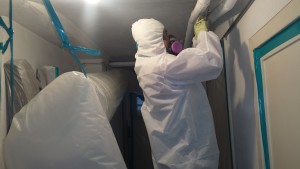Asbestos Roof Removal Checklist For Homeowners Removal Of Asbestos Roof In Area
Asbestos abatement guidelines are critical for making certain safety and minimizing health risks related to asbestos exposure - Successful Asbestos Roof Removal Stories. Asbestos is a naturally occurring mineral that was broadly used in construction materials and varied products due to its strength and heat resistance. However, prolonged exposure to asbestos fibers can lead to important health issues, including lung most cancers and mesothelioma. As such, dealing with asbestos requires careful planning and adherence to established guidelines
Before any abatement work begins, it is essential to conduct a thorough assessment of the positioning. This involves identifying all asbestos-containing materials (ACMs) current and understanding their situation. If they're damaged or deteriorating, the danger of fiber release into the air increases, making it essential to plan for removal or encapsulation.

Proper training for personnel concerned in asbestos abatement is paramount. Workers should endure specialised training to handle asbestos safely. This training ought to cover the use of private protective equipment (PPE), safe dealing with techniques, and emergency procedures for dealing with potential exposure. Additionally, only licensed professionals ought to carry out abatement activities, as they possess the experience required to manage hazardous materials successfully.
Asbestos Removal Liability Insurance Considerations Diy Awareness For Asbestos Removal
Effective communication performs an important function within the compliance with asbestos abatement guidelines. Property owners and contractors must be sure that all stakeholders are informed concerning the presence of asbestos and the proposed abatement plans. This contains notifying workers, tenants, and any relevant authorities about the potential hazards and the measures that shall be undertaken to mitigate risks.
Once the assessment is complete and a plan is in place, the next step includes choosing the appropriate abatement method. Common methods include removal, encapsulation, and enclosure. Removal involves the entire extraction of asbestos materials, whereas encapsulation seals the fibers in place to forestall launch. Enclosure, then again, includes setting up barriers to include the asbestos.
Proper containment procedures are very important during the abatement process. This includes utilizing plastic sheeting to seal off work areas and prevent contamination of the encompassing environment. Negative air pressure systems may be utilized to ensure that any airborne fibers are contained throughout the work space, further defending other areas of the building.

During the abatement process, frequent air monitoring is crucial. Safety Training For Asbestos Roof Removal Workers. This helps be sure that fiber levels stay below permissible limits. If testing signifies an increase in fiber levels, instant motion must be taken to deal with the contamination, which can contain halting work till the problem is resolved and further containment measures are put in place
Diy Asbestos Roof Removal Considerations Commercial Roofing Contractor For Removal
Once the abatement work is completed, proper disposal of the asbestos is critical. Asbestos waste have to be handled and transported according to local regulations, often requiring disposal at specialised landfills outfitted to administer hazardous materials. Clear labeling and secure packaging of the waste are crucial to forestall accidental exposure during handling and transport.
After the disposal, a follow-up inspection ought to be performed to verify that the abatement was profitable. This might involve further air monitoring and a visual inspection of the work space. Proper documentation of the whole process, including assessments, monitoring outcomes, and disposal data, is important for compliance and future reference.
Asbestos Roof Removal Service Reviews And Feedback Find A Licensed Asbestos Removalist
In addition to following these specific guidelines, common training and updates are crucial for all personnel concerned in asbestos management. Changes in regulations or best practices have to be communicated promptly to ensure ongoing compliance with safety requirements. Establishing a tradition of safety that prioritizes health and environmental issues can considerably enhance the effectiveness of any asbestos abatement program.
To sum up, the implementation of effective asbestos abatement guidelines is not only a regulatory requirement however a moral obligation to protect human health and the environment. The multifaceted strategy, together with assessment, training, containment, monitoring, and correct disposal, plays a vital function in minimizing the risks associated with asbestos exposure. Long-term vigilance and adherence to guidelines guarantee a safer environment for everybody.
In the top, effective management of asbestos ensures that communities are better protected against its hazardous effects. This requires ongoing collaboration amongst contractors, property house owners, regulatory bodies, and the workforce involved. By prioritizing safety and following established guidelines, it is possible to mitigate the dangers posed by asbestos and create more healthy living and working areas for all.
Asbestos Roof Removal Machinery And Tools Risks Associated With Asbestos Roofs
- Always conduct a thorough inspection and risk assessment by a licensed professional before beginning any asbestos abatement project.
- Develop a complete management plan that outlines the procedures, obligations, and safety measures to be adopted through the abatement process.
- Use applicable private protective equipment (PPE) similar to respirators, disposable coveralls, and gloves to stop exposure through the dealing with of asbestos-containing materials.
- Ensure that the work space is properly contained and ventilated to reduce the release of asbestos fibers into the encompassing environment.
- Implement decontamination procedures for staff and equipment, including dedicated wash stations and methods for safely disposing of asbestos waste.
- Notify local authorities and residents concerning the abatement project, adhering to any required regulations related to public safety and environmental safety.
- Utilize permitted asbestos abatement techniques, corresponding to encapsulation or removal, depending on the condition and location of the materials.
- Employ effective monitoring and air high quality testing earlier than, during, and after the abatement to make sure compliance with legal standards for airborne asbestos ranges.
- Train all personnel involved within the abatement process on safe dealing with practices and emergency response procedures to make sure a safe work environment.
- Keep detailed information of the whole abatement process, including inspections, abatement methods used, waste disposal documentation, and air high quality exams outcomes.undefinedWhat is asbestos abatement?
Asbestos abatement refers to the means of reducing or eliminating asbestos hazards in buildings. This can include removal, encapsulation, or enclosure of asbestos materials, performed by licensed professionals to ensure safety and compliance with regulations.
Why is asbestos abatement necessary?
Asbestos Regulations Affecting Roof Removal Residential Asbestos Removal Services
Asbestos abatement is important to guard human health. Asbestos exposure can lead to severe sicknesses, including lung cancer and mesothelioma. Proper abatement prevents asbestos fibers from becoming airborne and minimizes the chance of exposure.
What are the rules for asbestos abatement?
Asbestos abatement guidelines include following federal, state, and native regulations, conducting thorough inspections, organising proper safety protocols, using certified professionals, and documenting all procedures and findings for compliance and safety data.
Who ought to carry out asbestos abatement?
Asbestos Roof Removal Community Resources In Sydney Asbestos Storm Damage Services
Asbestos abatement should be carried out by skilled and licensed professionals who specialize in hazardous materials. They have the required instruments, information, and experience to conduct safe and effective abatement procedures.
What precautions are taken during asbestos abatement?
Precautions during asbestos abatement embody sealing off the work space, using protective gear, using HEPA-filtered vacuums, and ensuring proper waste disposal. Adhering to these precautions minimizes the danger of contamination and protects employees and residents.
How can I find licensed asbestos abatement contractors?
Asbestos Roofing Material Identification What To Do If You Find Asbestos
To find licensed asbestos abatement contractors, you possibly can check your state’s health division or environmental agency, search on-line directories, or request suggestions from native building authorities. Verify their credentials earlier than hiring.
What is the cost of asbestos abatement?
Finding Reputable Asbestos Removal Firms Find A Licensed Asbestos Removalist

The cost of asbestos abatement can vary broadly depending on factors such because the extent of asbestos present, location, and the complexity of the job. An preliminary inspection is commonly required to supply an accurate estimate.
Are there laws governing asbestos abatement?
Yes, there are quite a few laws and regulations governing asbestos abatement, including the Clean Air Act and OSHA regulations. These laws are designed to guard workers and the common public from hazardous exposure and description strict procedures that have to be adopted.
Asbestos Roofing Material Identification What To Do If You Find Asbestos
What ought to I do if I suspect asbestos in my home?
If you think asbestos in your house, keep away from disturbing the fabric and seek professional advice. It is advisable to rent an authorized inspector to evaluate the state of affairs and advocate applicable actions, corresponding to testing or abatement.
How long does an asbestos abatement project take?
The duration of an asbestos abatement project can range based mostly on the dimensions and complexity of the work. Most small to medium initiatives may be completed in a number of days, while larger, more difficult jobs could take weeks. Planning and scheduling are important for correct timelines.
Learn More here